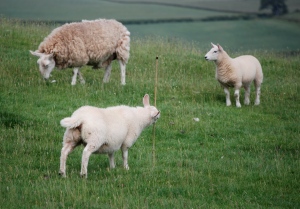Have you every wanted to be an archaeologist? Well it seems these artists have thought about it too!
Here’s the list followed by the lyrics and a brief explanation.
5. “Dig” by NOFX (Punk)
4. “Archaeologist” by Wintersleep (Alternative)
3. “Dig it” in Disney’s movie “Holes” (Musical)
2. “The Court of King Arthur” by Gruff Rhys (Alternative?)
1. “Traffic in the sky” by Jack Johnson (Folk-rock)
Number five
“Dig” by NOFX (Punk)
Underneath the city lies the ruins of mankind.
The excavation was a financial success,
With artifacts of gold.
The arrowheads went straight to the Smithsonian,
The rest was melted down and sold.
This song is clearly about an archaeological excavation. It’s down at number five due to questionable ethics. Seriously, no self-respecting archaeologist sells artifacts. Also an archaeological excavation is more like buying a car than an investment. You are never going to make money back, unless you strike oil in the process. Actually I stand corrected you can try and pull the whole “heritage tourism” thing. NOFX is still my favorite punk band, archaeology content aside.
Number four
“Archaeologist” by Wintersleep
Note- Canadian content!
See also Wintersleep’s song “Dance Macabre” with the line ‘all my friends are skeletons’. We, archaeologists, do see dead people. I don’t know if we’re friends, I would say we have a work-relationship! Insert visual picture of a skeleton by an office water cooler, with a mop nearby.
The archaeologists found
Some little boy’s remains
Staying by the fire and clouds
…
Packed up and shipped to London
Discard, discard the rotted parts
As if they’re hardened lungs.
Belly of a whale,
This song is gosh darn catchy and raises some ethical issues about archaeology.
The line about “discarding rotted parts” is clearly a reference to the Spitalfield crypt clearances. Honestly what do you do when the bodies are still…juicy? Do you display human remains? Do you rebury them after you have studied them?
Ok, I’m stretching it with the ethics bit but I really want to put this song in. It also breaks up the potential “dig” theme. Archaeologists do a lot more than just dig. Rumor has it that the Institute of Field Archaeologists (IFA) is going to change its name for a similar reason. Not all archaeologists are necessarily in the field. Welcome to the realm of post-modernity (still hate that term) inclusiveness.
Number three
“Dig it” in Disney’s movie “Holes” (Musical)
You gotta find something never found before,
If not, we’ll just have to dig some more.
…
I don’t take showers and I don’t brush my teeth
That’s all I do is dig holes eat and sleep
This is archaeology from an excavator’s perspective, well an excavator with poor hygienic practices. A running joke amongst archaeologists is that shovel bums are like mushrooms: left in the dark and fed shit. If there is poor communication within your unit/crew that feeling of “just keep digging” is very real. Also, I have talked with some ‘TV archaeologists’ and the first lines accurately express the pressure to “make good television”, mind you no one will stay on TV if they don’t brush their teeth or shower. Apparently, the movie/song is actually about a work camp but I will remain blissfully ignorant.
Number two
“The Court of King Arthur” by Gruff Rhys (Alternative?)
Aside: Gruff was formerly apart of Super Furry Animals. I found this song via Dr. Martin Rundkvist who called his post, about the song, “Super Furry Archaeology”. I am glad others make archaeology jokes too.
Digging deeper I hit on an ancient lump,
Lift my spade up,
And dig a bit deeper,
Must be careful with my magnetometer,
Excavation takes a long time;
First I survey,
Then I dig through the lime.
Good lord! It seems like some research about archaeological methods was employed when writing this song. Personally I have never dug through lime and generally, geophysics, i.e. the magnetometer, is used before the spade but I’ll take what I can get. It’s hard to think of archaeological terms that rhyme so I will cut Gruff some slack. Partially due to his awesome name. This song dropped a spot for the use of ‘radiocarbon-dating’ as a lame double entendre, those lyrics are not included but can be found through the above hyper link.
Number one
“Traffic in the sky” by Jack Johnson (Folk-rock)
Puzzle pieces in the ground
But no one ever seems to be digging
Instead they’re looking up towards the heavens
…
The answers could be found
We could learn from digging down
But no one ever seems to be digging
This song is number one due to its subtly. This song is probably also the most well known.
Oh, Jack! A dedicated few of us are digging down and let me tell you this “puzzle” very tricky. You know what helps unravel the puzzle, funding! Nudge, nudge.
Way to stick it to those star-gazing, glory hogs! Clearly, Jack is taking sides. When the geologists/archaeologists eventually face off against the astronomists/astrophysicists in an academic Jets vs Sharks style battle, Jack mother-effin’ Johnson has our backs! Folk does make crappy fight music though.
Honestly, do you know how hard it is to find archaeology-themed lyrics?! I am sure there are many more that I missed. Feel free to drop me a line and lets see if we can bump this list up to 10!

